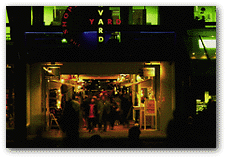Main Menu · Search · Current Issue · Contact · Archives · Centennial · Letters to the Editor · FAQs
![]()
Main Menu ·
Search · Current Issue · Contact · Archives · Centennial · Letters to the Editor · FAQs
![]()
| A Dean's Half Decade | Disunion, Continued |
| Harvard Portrait | Dreams Deferred |
| Front-Door Policy | Kroks Around the Clock |
| The Undergraduate | People in the News |
| Sports | The University |
[ The following article, published in our May-June issue, erroneously reported that some businesses outside Holyoke Center's retail arcade would be forced to vacate their premises as Harvard Planning and Real Estate undertakes a planned redesign of "The Shops by Harvard Yard." In fact, the only businesses affected are those located within the arcade, surrounding the building's elevator lobby. The Ma Soba and Au Bon Pain restaurants, on Mt. Auburn Street and Massachusetts Avenue, respectively, and the retailers along Dunster Street are staying put. We regret the error. ]

![]()
You remember "The Shops by Harvard Yard" in the arcade of Holyoke Center. When Harvard Real Estate opened the mini-mall in the fall of 1993, some observers thought it an unseemly embrace of commerce in the middle of the campus. "The whole project in concept and execution is demeaning to the local community and ought to be an embarrassment to the President and Fellows of Harvard College," wrote one critic in a letter to the editor of this magazine (March-April 1994, page 7). The mall soon proved an economic failure. Its shops, eateries, and mobile kiosks opened and closed like morning glories. At the start of this year Harvard announced that it would abandon the flops by Harvard Yard and pursue a new concept for the space.
"`The Shops by Harvard Yard' have not met our financial or programmatic expectations," says Scott Levitan, M.A.U. '84, a vice president of Harvard Planning and Real Estate. "After considerable outreach among our University constituents, we have developed a new leasing strategy for the arcade, envisioning it as a gateway to Harvard, as Harvard's front door."
A number of Harvard offices that have dealings with the public already operate in the Holyoke arcade or in storefronts around the perimeter of the high-rise building: an information center, the housing and employment offices, the University Press display room, the Health Services' optical shop and pharmacy. Levitan hopes other "service" offices will join them, including some that do not now exist: a central ticketing office, for example, or perhaps some sort of exhibition area highlighting the University's museums. Such offices, says Levitan, "would have to generate enough income to enable them to pay some sort of rent, although not what a commercial operation would pay, to cover our expenses on the space." Levitan is searching for a major tenant who will open an establishment offering food, computers, and on-line services, a techno-culinary combo with proven appeal elsewhere in the Square. Such a place could keep the arcade humming into the evening.
What's to become of the "shops" still doing business in the arcade? In January Levitan told the nine kiosk operators that their three-month licenses could be renewed twice, but that they would have to move on by summer. The other enterprises-a necktie store, two fancy gift shops, a dispenser of fast Middle Eastern and Tex-Mex food, and a Pan Asian noodle restaurant-are entitled to stay until their leases are up. (The longest-running lease expires at the end of 1998.) But they may not wish to do so. Starting after Commencement, Harvard will begin to renovate the arcade, a phased undertaking but inevitably a disruptive one. "There are some physical issues that need to be addressed," says Levitan.
When Josep Lluis Sert, architect of Holyoke Center (and dean of the School of Design), came to design the arcade some 35 years ago, he had a bad day. The passageway through his block-square building was a concrete wind tunnel. In an attempt to control wind pressure, Harvard in 1993 closed the arcade at the Mount Auburn Street end with heavy glass doors. That helped. But on three occasions weather fronts have presented the doors with atmospheric pressures they could not handle, and have shattered them. In the 1993 remodeling, architects also rigged an air curtain at the Forbes Plaza end of the arcade. In cool weather, warm air blowing down from the ceiling is supposed to form a barrier and keep the arcade toasty. The curtain rearranges one's hair dependably, does only moderately well at keeping temperatures steady, and is costly to operate. Levitan says he needs to do something about both ends of the arcade.
The expensive overhaul the arcade got in 1993 brought some unquestioned improvements to an unloved space. These will endure into the new front-door era. Perhaps chief among them: Harvard in its mercy installed safe and clean public toilets in an elevator lobby off the arcade. It is difficult to imagine a greater gift to the local community.
Main Menu ·
Search · Current Issue · Contact · Archives · Centennial · Letters to the Editor · FAQs
![]()